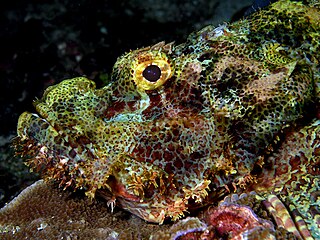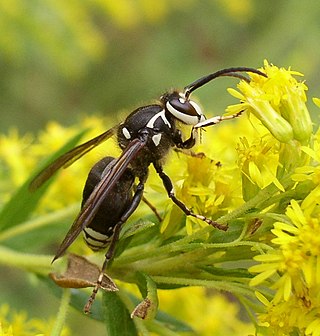
The Mutillidae are a family of more than 7,000 species of wasps whose wingless females resemble large, hairy ants. Their common name velvet ant refers to their resemblance to an ant, and their dense pile of hair, which most often is bright scarlet or orange, but may also be black, white, silver, or gold. Their bright colors serve as aposematic signals. They are known for their extremely painful stings,, and has resulted in the common name "cow killer" or "cow ant" being applied to the species Dasymutilla occidentalis. However, mutillids are not aggressive and sting only in defense. In addition, the actual toxicity of their venom is much lower than that of honey bees or harvester ants. Unlike true ants, they are solitary, and lack complex social systems.

The Scorpaenidae are a family of mostly marine fish that includes many of the world's most venomous species. As their name suggests, scorpionfish have a type of "sting" in the form of sharp spines coated with venomous mucus. The family is a large one, with hundreds of members. They are widespread in tropical and temperate seas but mostly found in the Indo-Pacific. They should not be confused with the cabezones, of the genus Scorpaenichthys, which belong to a separate, though related, family, Cottidae.

Vespoidea is a superfamily of wasps in the order Hymenoptera. Vespoidea includes wasps with a large variety of lifestyles including eusocial, social, and solitary habits, predators, scavengers, parasitoids, and some herbivores.

The Mydidae, or Mydas flies, are a cosmopolitan family of flies. It is a small family, with about 471 species described. They are generally large in size, including the largest known fly, Gauromydas heros. Many of the species, in addition to their large size, are mimics of stinging hymenopterans, especially wasps. Most mydids are found in arid and semiarid regions of the world, but they are also found in other habitats.

The Gasteruptiidae are one of the more distinctive families among the apocritan wasps, with surprisingly little variation in appearance for a group that contains around 500 species in two subfamilies and with 6 genera worldwide. They are members of Evanioidea.

The Stephanidae, sometimes called crown wasps, are a family of parasitoid wasps. They are the only living members of the superfamily Stephanoidea. Stephanidae has at least 345 living species in 11 genera. The family is considered cosmopolitan in distribution, with the highest species concentrations in subtropical and moderate climate zones. Stephanidae also contain four extinct genera described from both compression fossils and inclusions in amber.

Dolichopodidae, the long-legged flies, are a large, cosmopolitan family of true flies with more than 7,000 described species in about 230 genera. The genus Dolichopus is the most speciose, with some 600 species.

Empididae is a family of flies with over 3,000 described species occurring worldwide in all the biogeographic realms but the majority are found in the Holarctic. They are mainly predatory flies like most of their relatives in the Empidoidea, and exhibit a wide range of forms but are generally small to medium-sized, non-metallic and rather bristly.

Dryinidae is a cosmopolitan family of solitary wasps. Its name comes from the Greek drys for oak: Latreille named the type genus Dryinus because the first species was collected in an oak plant in Spain. The larvae are parasitoids of the nymphs and adults of Auchenorrhyncha. Dryinidae comprises approximately 1900 described species, distributed in 17 subfamilies and 53 genera.

Apatelodidae, the American silkworm moths, is a family of insects in the order Lepidoptera. They are a family within the superfamily Bombycoidea, though they have in the past been considered a subfamily of Bombycidae.

Acaenitinae is a subfamily of the parasitic wasp family Ichneumonidae. It is distributed on all continents except Antarctica, although only one specimen (from the genus Arotes has ever been discovered in South America. Little is known of the Acaenitinae. The only reared species was a koinobiont endoparasitoid of a weevil. There are 24 genera. Hosts are believed to be Coleoptera larvae in wood. Female Acaenitinae have a large triangular projecting genital plate.

The Sierolomorphidae are a family of 13 extant species of wasps, in the genera Sierolomorpha and Proscleroderma, mostly found in the Northern Hemisphere. They are rare and very little is known of their biology. A fossil species Loreisomorpha nascimbenei has also been placed in the family.
Armaniidae was a name formerly given to a group of extinct ant-like hymenopterans known from a series of Cretaceous fossils found in Asia and Africa. Armaniidae has been suggested by several authors to belong to the family Formicidae as one of the stem-group subfamilies, Armaniinae; however, this position has not been taken up by myrmecologists. The family contained seven described genera and thirteen described species. An analysis of fossil ants based on antenna structure in 2017 resulted in three of the family being broken up with some genera being moved to Sphecomyrminae and other genera being relegated to incertae sedis in Formicidae or Aculeata.
Shireplitis is a genus of braconid wasps native to New Zealand. Individuals range from 1.8 to 2.4 mm in body length. Five of the six known species occur on South Island, and one on the North Island. The genus name derives from the Shire, fictional home of the hobbits in the works of J. R. R. Tolkien, and five species are named after hobbits, with one species named after Tolkien himself.

The Thynnidae are a family of large, solitary wasps whose larvae are almost universally parasitoids of various beetle larvae, especially those in the superfamily Scarabaeoidea. Until recently, the constituents of this family were classified in the family Tiphiidae, but multiple studies have independently confirmed that thynnids are a separate lineage.

The Chyphotidae are a family of wasps similar to the Mutillidae, differing most visibly in the presence, in females, of a suture separating the pronotum from the mesonotum. These species are found primarily in arid regions in the southwestern United States and adjacent regions in Mexico.

Eumolpini is a tribe of leaf beetles in the subfamily Eumolpinae. It is the largest tribe in the subfamily, with approximately 170 genera found worldwide. Members of the tribe almost always have a longitudinal median groove on the pygidium, which possibly helps to keep the elytra locked at rest. They also generally have a subglabrous body, as well as appendiculate pretarsal claws.

Zigrasimeciinae is a subfamily of ants, known from the Cretaceous period, originally named as the tribe Zigrasimeciini within the subfamily Sphecomyrminae by Borysenko, 2017, it was elevated to full subfamily in 2020. It contains three described genera. They are sometimes known as iron-maiden ants in reference to their densely spiked mouthparts, reminiscent of an iron maiden torture device, that were likely used to trap prey. Boltonimecia canadensis was described from Campanian Canadian amber out of Alberta, Canada, while the species of Protozigrasimecia and Zigrasimecia are both exclusively known from Cenomanian Burmese amber found in Myanmar.
















